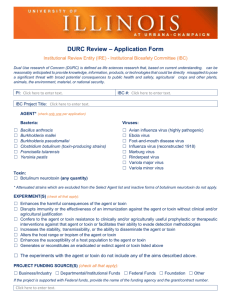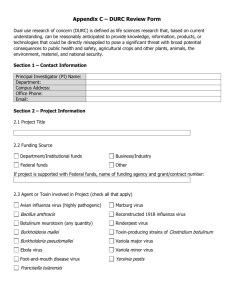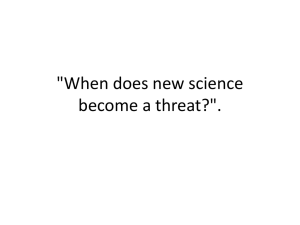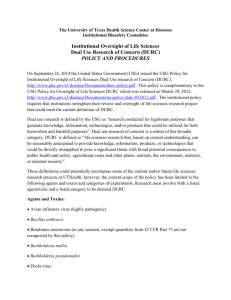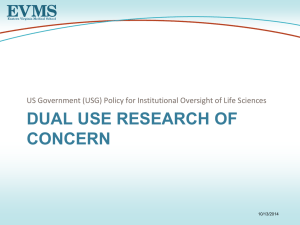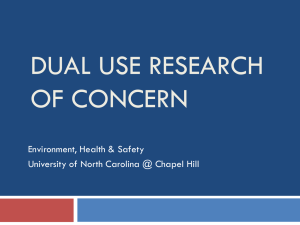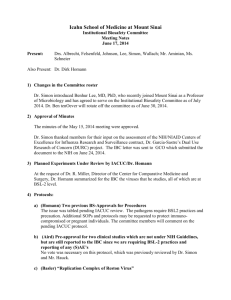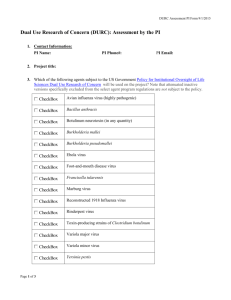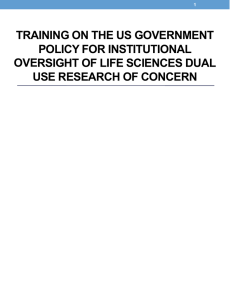Report of the WHO Informal Consultation on Dual Use Research... Geneva, Switzerland 26-28 February 2013
advertisement
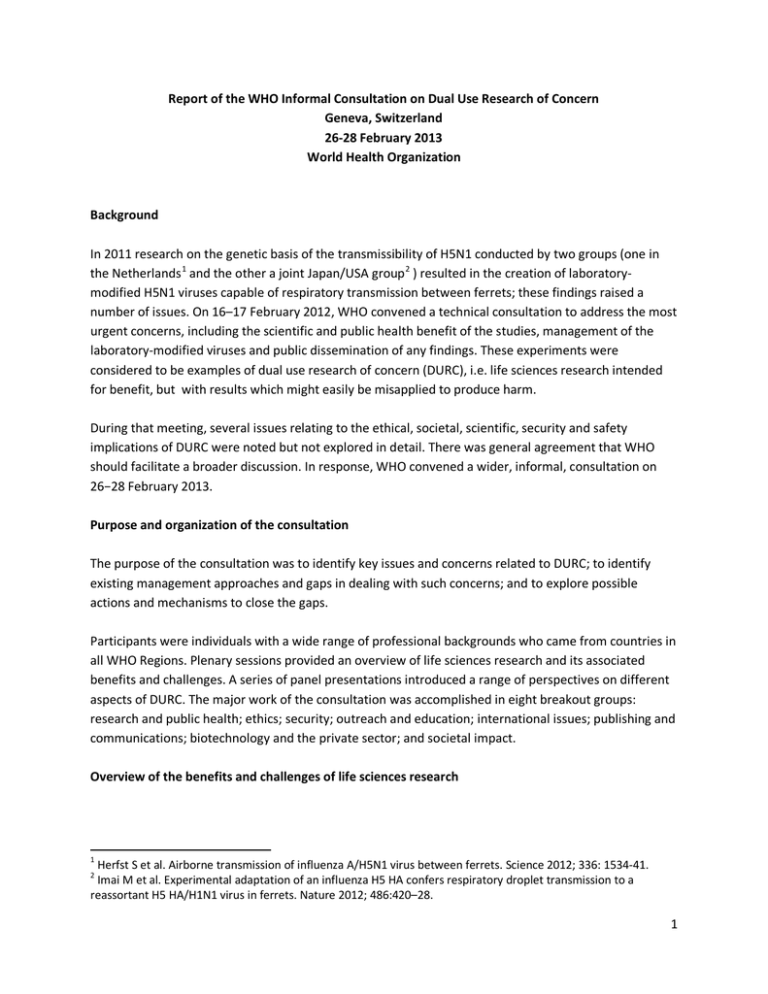
Report of the WHO Informal Consultation on Dual Use Research of Concern Geneva, Switzerland 26-28 February 2013 World Health Organization Background In 2011 research on the genetic basis of the transmissibility of H5N1 conducted by two groups (one in the Netherlands 1 and the other a joint Japan/USA group 2 ) resulted in the creation of laboratorymodified H5N1 viruses capable of respiratory transmission between ferrets; these findings raised a number of issues. On 16–17 February 2012, WHO convened a technical consultation to address the most urgent concerns, including the scientific and public health benefit of the studies, management of the laboratory-modified viruses and public dissemination of any findings. These experiments were considered to be examples of dual use research of concern (DURC), i.e. life sciences research intended for benefit, but with results which might easily be misapplied to produce harm. During that meeting, several issues relating to the ethical, societal, scientific, security and safety implications of DURC were noted but not explored in detail. There was general agreement that WHO should facilitate a broader discussion. In response, WHO convened a wider, informal, consultation on 26−28 February 2013. Purpose and organization of the consultation The purpose of the consultation was to identify key issues and concerns related to DURC; to identify existing management approaches and gaps in dealing with such concerns; and to explore possible actions and mechanisms to close the gaps. Participants were individuals with a wide range of professional backgrounds who came from countries in all WHO Regions. Plenary sessions provided an overview of life sciences research and its associated benefits and challenges. A series of panel presentations introduced a range of perspectives on different aspects of DURC. The major work of the consultation was accomplished in eight breakout groups: research and public health; ethics; security; outreach and education; international issues; publishing and communications; biotechnology and the private sector; and societal impact. Overview of the benefits and challenges of life sciences research 1 Herfst S et al. Airborne transmission of influenza A/H5N1 virus between ferrets. Science 2012; 336: 1534-41. Imai M et al. Experimental adaptation of an influenza H5 HA confers respiratory droplet transmission to a reassortant H5 HA/H1N1 virus in ferrets. Nature 2012; 486:420–28. 2 1 All countries benefit from life sciences research. It has generated the most important biomedical and public health advances in recent decades. The development of state-of-the-art vaccines (e.g. vaccines for hepatitis B virus and human papilloma virus); drugs (e.g. recombinant insulin and blood clotting factors); and diagnostics (e.g. tests for hepatitis C virus and human immunodeficiency virus) have been possible because of life sciences research. The accelerated pace of life sciences research is facilitated in part by widespread access to information and communication technologies, the availability of faster and higher-capacity technological tools, and the ever-decreasing cost of technology. These advances, however, also present new challenges as good science can be put to bad uses. Gene cloning (i.e. copying) techniques that have led to new vaccines could be misused to produce a harmful toxin or to increase the virulence of a microorganism capable of infecting humans. Beneficial applications of synthetic biology include the development of new drugs; misapplication of this discipline could lead to the design of new or modification of existing pathogens as agents of bioterrorism. Much of the knowledge and technologies generated by legitimate life sciences research could theoretically have some potential to be misused. DURC, however, comprises a limited subset of all life sciences research, i.e. research intended for beneficial purposes, but which might easily be misapplied to do harm. In addition to the previously noted H5N1 studies, a limited number of other research studies have raised concerns about the potential for ready misuse and subsequent consequences for public health, safety and national security. 3 Management of DURC-related risks has been approached in several ways, including: 1) research oversight mechanisms; 2) policies for funding agencies; 3) international and national regulations and frameworks, such as the International Health Regulations (2005) and the Biological and Toxin Weapons Convention; 4) institutional and professional codes of conduct and ethics; and 5) awareness-raising and educational initiatives for a range of audiences. 4 Some of these approaches have included criteria or descriptions of the types of research that would trigger concern and further evaluation; 5,6,7,8 such as experiments that would: • demonstrate how to render a vaccine ineffective 3 World Health Organization. Responsible life sciences research for global health security: a guidance document. Geneva 2010. Available at: http://www.who.int/csr/bioriskreduction/lifesciences_research/en/. 4 WHO, 2010. 5 United States Government policy for institutional oversight of life sciences dual use research of concern. Available at: http://www.phe.gov/s3/dualuse/Documents/oversight-durc.pdf. 6 National Research Council on Research Standards and Practices to Prevent the Destructive Application of Biotechnology. Biotechnology research in an age of terrorism. Washington, DC, National Academies Press, 2004. 7 Miller S and Selgelid MJ. Ethical and philosophical consideration of the dual-use dilemma in the biological sciences. Dordrecht NE, Springer, 2008. Report prepared by the Centre for Applied Philosophy and Public Ethics at the Australian National University for the Australian Department of Prime Minister and Cabinet, National Security Science and Technology Unit, November 2006. 8 Steinbruner J et al. Controlling dangerous pathogens – a prototype protective oversight system. Center for International and Security Studies at Maryland (CISSM), 2007. 2 • • • • • • • • confer resistance to antibiotics or antiviral agents enhance the harmful consequences of a pathogen or toxin or render a non-pathogen virulent increase the transmissibility of a pathogen alter the host range of a pathogen or toxin enable evasion of diagnostic or detection modalities enhance the susceptibility of a host population to a pathogen or toxin generate or reconstitute certain eradicated or extinct pathogens or toxins enable weaponization of a biological agent or toxin. Oversight mechanisms are essential, and codes of conduct are important in ensuring awareness and building commitment to an ethically aware, legitimate research enterprise, but would likely have minimal impact on those who operate outside the system and are intent on causing harm. Consultation The deliberations of the breakout groups and the panel and plenary discussions identified a number of issues, concerns and gaps related to the conduct and management of DURC; possible actions to respond to these problems were also considered. These discussions are summarized in the following issueoriented perspectives and themes. DURC is an issue for all countries and multiple stakeholders Scientific research is conducted in virtually all countries and is critical to strengthening global response to all health threats and hazards, including those posed by naturally occurring and by accidentally or intentionally released biological agents. The only way to eliminate the potential for misuse of DURC is to not perform research. Such an extreme solution, however, is neither feasible nor advisable. The global capacity to detect, monitor, counter and prevent well characterised or emerging and re-emerging infectious disease threats such as AIDS, severe acute respiratory syndrome (SARS), and pandemic influenza relies on the tools and techniques generated by life sciences research. Finding solutions to mitigate and manage the inherent risks associated with DURC, therefore, is essential to global health security. Although a major focus of the discussion was on biological research that relates to human health, DURC is also applicable to animal and plant health and can apply as well to research in non-biological fields (such as engineering or information technology) that bears on human, plant or animal health. Participants noted the importance of strengthening links across these fields to illuminate the range of DURC origins and expressions. DURC has implications for a broad range of sectors and stakeholders, including, among others, researchers, public health professionals, the security community, funding agencies, professional societies, electronic and print publishers and media, the legal community, national governments and other oversight bodies, and civil society. 3 The management of DURC-related risks should take into account all stages of the research cycle Consideration of dual use potential should start early in the research process, from the time of initial conceptualization and development of a proposal, to review and provision of funding, to conduct of the research, analysis of results, storage and potential use of material results, including modified biological agents, and dissemination of findings. Participants noted many gaps and uncertainties in the management of DURC-related risks along this continuum. Researchers are familiar with the identification and management of laboratory biosafety 9 and biosecurity 10 issues. Regulatory approaches, including tools, training and guidance for biosafety and biosecurity, are available to assist with implementation and compliance. In contrast, there is less awareness and knowledge about “information security” issues in the scientific community. Scientists, not surprisingly, may not always recognize the potential risk for misuse of their research nor know how to reduce this risk. The expertise of the security community is more attuned to assessing and identifying research methods and findings that could be misused. In addition, information about the potential implications for DURC may not be apparent at the start of a research project, as research can sometimes lead to unanticipated results. There may be benefits, therefore, in periodic review of research projects in progress to consider if any issues, including potential for dual use, have arisen. Representatives of funding agencies outlined their approaches to reduce potential risks for misuse of information generated by research they support. Some funding agencies have developed targeted policies and procedures for DURC, with clear requirements for assessment before approval of funding, and through the periodic reviews performed during the course of the project. Others rely on institutional requirements, national laws and/or guidelines relating to biosecurity, ethics and the like. Efforts to limit the spread of harmful information at the point of publication are particularly difficult and may be of limited effectiveness. Review for DURC implications should begin far earlier in the research cycle. There are no standard procedures for handling manuscripts with the potential for misuse of information. Some journal editors have devised different mechanisms for papers that may require additional internal and/or external deliberation. In some instances, authors may be asked to provide clarifications and added text on the risks and benefits of research findings. The value of redacting text in a manuscript as a means of limiting risk was a point of dissent among participants. Redaction presents difficult challenges and choices: there are no agreed guidelines on how to do this; there is a lack of clarity as to how to control information, who has the right to know it and who does not. Redaction also assumes that information can be successfully restricted. Participants noted, however, that legal mechanisms to do this may be lacking. If redaction is not used, journal editors 9 Laboratory biosafety refers to the containment principles, technologies and practices that are implemented to prevent unintentional exposure to biological agents, toxins, or their accidental release. WHO, 2010. 10 Laboratory biosecurity refers to the protection, control and accountability for valuable biological materials within laboratories, in order to prevent their unauthorized access, loss, theft, misuse, diversion or intentional release. WHO 2010. 4 have a limited number of options, such as adjusting the timing of publication or commissioning an accompanying paper on risks and benefits. If the decision is made not to publish, authors may submit their work to other journals or simply post it on the internet. Journal editors emphasized the lack of guidance regarding: the type of research to be concerned about; how to screen for such papers; who to involve in discussions; and who has ultimate responsibility for identifying and resolving situations with potential DURC manuscripts. The range of stakeholders identified in publishing and communications is extensive: academic and industrial scientists, conference organizers, funding agencies, general media, amateur scientists, and scientific societies are amongst those who should be engaged. Research oversight mechanisms are important Some countries and institutions have developed oversight mechanisms to manage DURC-related risks. Many, however, have not done so, owing to competing demands on resources and capacity, limited awareness of the issue, or a perception that it is not relevant to their particular context or priorities. Nonetheless, oversight mechanisms that take into account both the benefits of undertaking such research as well as the risks are important. Development of oversight mechanisms that are effective but do not compromise the conduct of legitimate research and access to research findings is very challenging. Assessing whether research methodologies and/or findings constitute DURC requires an understanding of adversaries’ capabilities and intent, as well as an in-depth understanding of the experimental details. Even with training and expert input, differences may arise when assessing the potential for misuse. The near- and far-term benefits of research may not always be immediately evident. Similarly, risks can be difficult to quantify as biological systems are complex. Oversight mechanisms for DURC, nonetheless, should be commensurate with risk. The increasing aversion to risk by society and policy makers was noted with concern as it may inhibit or impede research that can lead to improvements in health and in economic and social development. The ability to perform the research required for response and control of serious health events is crucial and must be preserved. There was wide agreement that it is in everyone’s best interest to have full and open access to research methodology and results. This allows for validation or repudiation of research findings; it facilitates scientific progress by allowing researchers to build upon other findings; it fosters public trust; and it is essential for international collaborations, an increasing hallmark of contemporary research. The potential risks of full and open communication would be expected to outweigh the benefits in only the rarest circumstances. Security classification and export controls are tools that are available to many countries for use in those rare circumstances where restricted communication is necessary. Research undertaken in the private sector poses special challenges. The private sector cuts across a wide and diverse swath of academia, industry, non-profit organizations, contract research organizations, small and medium-sized enterprises, trade associations, industry consortia, and investors, amongst 5 others. The decreasing cost of technological tools has encouraged the involvement of more people, including the “do-it-yourself” or home experimenter and small “start-up” companies. Technological advances make it possible for research findings to be widely disseminated. Some, but not all, entities in the private sector fall under traditional mechanisms for oversight and regulation; oversight of those that do not may be limited. Intellectual property regulations may impede the dissemination of potentially harmful information, but also hamper assessment of the full scope of research being undertaken. Outreach and education, therefore, are essential to help ensure that the private sector is aware of DURC and of the potential for misuse of research information. Inclusion of a wider range and number of participants from the biotechnology and private sector is to be encouraged in discussions about DURC. Enhancing capacity in laboratory biosafety and laboratory biosecurity is a more immediate concern for developing countries; many countries lack capacity for managing DURC but do not currently see this as a priority, as they face other urgent health challenges. Oversight mechanisms enacted in more developed countries, however, can have substantial impacts on developing countries and limit opportunities for collaborative research, training and access to research materials. Managing DURC at country level: a diversity of approaches The inventory, sharing, and, where needed, development, of guiding principles, toolkits, best practices and other forms of technical assistance would help countries formulate their own policies and procedures for managing DURC. Although establishment of a legally binding global agreement or regulation is theoretically possible, such an approach would be expensive, slow, likely impractical and would not necessarily yield the desired benefits. The lengthy and complex review of the two H5N1 experiments underscored the need for 1) clarity on the types of research that should trigger further examination for issues of biosafety, biosecurity and DURC and 2) criteria and practical tools for weighing the relevant interests of all stakeholders involved at all stages of the research process. There was a diversity of views on how to meet these needs. Many countries and institutions have chosen to emphasize the role of self-governance by the scientific community and the need to embed dual use management measures into existing research oversight mechanisms. International regulations, frameworks, initiatives and prototypes, such as the International Health Regulations (2005), the Biological and Toxin Weapons Convention (BWTC), the Center for International Security Studies’ Biological Research Security System, and institutional and professional codes of conduct could serve as potential resources for countries when developing policies and procedures for DURC. It was observed, however, that these approaches are unevenly implemented across countries, they are not coordinated or harmonized and none of them sufficiently addresses DURC. While some participants expressed support for global harmonization of standards, others advocated for adaptation of a set of fundamental principles to design locally appropriate approaches. The lack of global guidance or a framework for management of DURC that bridges the many stakeholder communities was repeatedly noted as a critical gap. Suggested elements for global guidance/framework 6 included overarching principles, categories of experiments of potential concern, and strategies for risk/benefit assessment and mitigation of risk. Development of such a framework would require a forum where key stakeholders, governments and international organizations can come together. Participants emphasized that WHO could play a vital role in convening in this regard. International organizations such as the Food and Agriculture Organization of the United Nations (FAO) and the World Organisation for Animal Health (OIE) can play a similar role for agriculture and animal life sciences research. Communication across a broad range of sectors and stakeholders is essential Communication and continuing dialogue across a broad range of sectors and stakeholders are essential to create a culture of responsibility, cooperation and trust. In particular, improving mutual understanding of the various approaches to risk identification and assessment among stakeholders will be critical to establishing that dialogue. It was acknowledged that at times a certain amount of tension or distrust has characterized the relationship between the security and scientific communities. The inability of security experts to share specific information about the likelihood of misuse and harm from research findings creates a level of asymmetry in the relationship between the two groups. The two groups, however, are reliant upon each other: researchers need the expertise and advice of security experts to assess potential security risks associated with DURC, and the security community depends on scientists for technical information and perspectives on non-security contexts to help inform their assessment. Security experts noted the complexities in assessing and quantifying risk for what may be unpredictable and/or low probability events, but which entail a high impact should they occur. It was observed that a very similar challenge was faced by public health scientists working on severe emerging diseases, and that there might be ways to develop a common language and compatible methodologies for describing risk. An optimally functioning relationship between scientists and security experts requires mutual engagement to bridge gaps in communication, collaboration and culture. The public is an essential stakeholder in DURC. Openness and transparency about DURC can help to ameliorate public fears, counter rumours and misinformation, and increase public confidence. Participants allowed that efforts to increase the public’s understanding of DURC, including both the benefits and risks of such research, and the role of biosafety and biosecurity measures have been limited. Inequity of access to technology and the benefits of life science research, including DURC, can feed public mistrust. The audiences for education and training are diverse Awareness-raising, education and training on biosafety, biosecurity and DURC are essential not only for researchers but also for all sectors and stakeholders. It needs to occur at all levels—global, national, institutional, and the individual investigator—and incorporate diverse perspectives, including those of foreign ministers, policymakers and regulators. Training researchers and students who will become researchers was particularly emphasized. 7 Education and training must be practical and suitable for a wide range of audiences; it can include guidance, toolkits, best practices, and case studies. Incorporation of DURC into existing curricula and educational programs may be efficient and economical. Codes of Conduct are another way to increase awareness of biosafety, biosecurity and the potential for misuse of life sciences research. It is important that all forms of outreach and educational training provide information about both the benefits as well as the risks of DURC. Education and communication activities have been hampered by significant challenges. The lack of standardized definitions and terminology that are universally accepted across sectors and stakeholders leads to confusion and misunderstanding as does the lack of harmonization among existing guidelines, regulations, codes of conduct and the like. Guidance and tools to identify and manage risks require significant development and must include the entire spectrum of the research process from inception to publication. Training for DURC can be integrated with other capacity development activities for developing countries. Many countries will require financial as well as technical support to undertake culturally and contextually appropriate education and training. Ethical considerations are fundamental to management of DURC Questions about the governance of dual use life science research of concern are inherently ethical in nature: what are the responsibilities of various actors; how can the benefits of research, including DURC, be promoted while avoiding harm or minimizing risk; and how can conflicting or divergent priorities be reconciled, i.e. the importance of scientific freedom and progress versus the importance of security. DURC raises ethical questions for a broad range of sectors and stakeholders at different hierarchical levels of the governance of science: • • • • • • • individual scientists who must decide what research to conduct and to publish research institutions, which must decide, among other considerations, how to regulate research within their confines; how to educate their researchers; and which laboratory security measures should be in place funding organizations, which must decide how considerations of DURC are incorporated in the application and review processes professional societies, which must make decisions about the development, promulgation and/ or enforcement of codes of conduct and education editors and publishers, who must make decisions regarding the review and publication of potentially dangerous papers national governments, which must decide the extent to which important considerations such as review of research and the relevant education of scientists will be mandated, how to bring in the essential stakeholders to formulate sound policies, if/which DURC can be funded, and the extent to which controls should be placed on access to potentially dangerous material international organizations, which must make decisions concerning relevant global policy. 8 As in other areas of ethics, absolutist or polarizing approaches to governance of DURC should be avoided. The diversity of actors demands a multi-pronged approach to governance of DURC. Diverse kinds of measures working in concert (a “web of prevention”) offer the best chance of achieving a successful balance between benefit and risk. The global consequences of DURC are such that no single national approach can fit the needs and concerns of all countries. Some participants noted that the degree to which research ethics are prioritized varies across the world. Different levels of resourcing in comparison to acute needs, cultural differences, the way some ethical guidelines are developed and disseminated, and misconceptions about their application all contribute to this. Enlightened leadership, which values ethics, along with vision, safety, responsibility and accountability, as essential components of high-quality research should be embraced and promoted. Next steps This informal consultation provided an opportunity to explore a wide range of the complexities and interdependencies posed by consideration of DURC. Robust and beneficial life sciences research must be balanced with measures to reduce potential misuse or misapplication of knowledge. WHO will engage with Member States and others to assess how best to encourage effective approaches. 9
